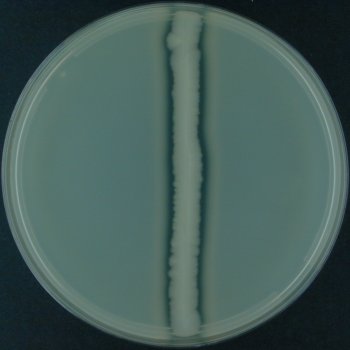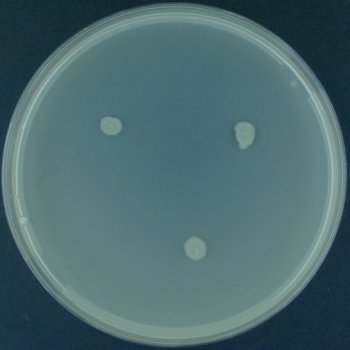Table of Contents
| Test Name | Casein Hydrolysis Test |
| Detection | Enzyme caseinase producing microorganisms |
| Uses | To show that some microorganisms can make enzymes outside of their cells that can break down the milk protein casein. |
| Result | A clear, transparent zone can be seen around the area where the colonies are growing, or sometimes under the area where the colonies are growing. |
| Require | Casein agar plates or skim milk agar plates, 10% Trichloroacetic acid solution, Sterilized microtips, spreaders and inoculation loop, Bacterial and fungal cultures can be bought or taken from soil to test how well they break down casein. In general, Bacillus species are good at breaking down casein. |
| Quality Control | Positive Control: Nocardia brasiliensis Negative Control: Nocardia asteroides |
- Casein is the protein that gives milk its white colour and is responsible for 85% of the protein in milk.
- Casein is too big to fit inside bacterial cells.
- Bacterial cells release proteolytic exoenzymes (caseinases and peptidases) that break down casein into amino acids so that it can be used. It’s easy to get amino acids into cells, where they are broken down.
- By growing an organism on milk agar, you can check to see if it has caseinase activity.
- Milk agar looks like milk because it is white. Caseinase-positive microorganisms will locally hydrolyse the casein in the plate forming clear zones around bacterial colonies.
- A coloured reagent is added to the milk agar to make this more clear.
- When proteases are made by the bacteria on the plate, the coloured reagent will lose its colour.
Purpose of Casein Hydrolysis Test
- To show that some microorganisms can make enzymes outside of their cells that can break down the milk protein casein.
Casein Hydrolysis Test Principle
Casein Agar is made of agar and skim milk, which has casein in it. Some aerobic actinomycetes make a hydrolytic enzyme that breaks down casein. This clears the soil around and under the growing areas.
Casein is too big to fit through the membrane of a bacterial cell. So that the bacteria can use the casein, they send out proteolytic exoenzymes (caseinase and peptidase) that break the protein down into amino acids. After transport proteins take the amino acids across the cell membrane, the cells can use them. Casein hydrolysis is tested by growing an organism on a skim milk agar plate and giving it food and casein. The plates are then checked to see if the casein has been broken down. If there is no hydrolysis, the casein will make the plates white. If there is hydrolysis, there will be clear zones around the growth.
Requirement
- Bacterial cultures: Bacterial and fungal cultures can be bought or taken from soil to test how well they break down casein. In general, Bacillus species are good at breaking down casein.
- Culture medium: Casein agar plates or skim milk agar plates.
- Chemicals: 10% Trichloroacetic acid solution
- Miscellaneous: Sterilized microtips, spreaders and inoculation loop
Composition of Skim Milk Agar
| Ingredients | Gram per liter |
| Skim milk powder | 28.0 |
| Trypton | 5.0 |
| Yeast extract | 2.50 |
| Dextrose | 1.0 |
| Agar | 15.0 |
Preparation of Skim Milk Agar
- Except for the agar, each part of the medium is dissolved in 500 ml of distilled water in 1000 ml flasks. The pH of the medium is set to 7.0.
- Then, the agar powder is added, and the medium is filled to 1000 ml.
- The medium is then autoclaved at 121°C for 15 min at 15 psi.
- The medium that has been heated in an autoclave is then poured into clean Petri dishes and left to harden. Alternatively, ready-made mediums can be used.
Procedure of Casein Hydrolysis Test
- Use a pure culture of the test isolate to heavily inoculate a 10 mm square of the Casein Agar surface. Press the inoculum into the surface of the agar to make sure it stays there.
- Use cellophane tape, Shrink-Seals, or a strip that lets gas through to seal the plate.
- Incubate at 25-30°C with air for 14 days.
- Check the plate every 3–4 days for clearing (hydrolysis) around or right under the colony. This is a sign of a good reaction. Wait 14 days before deciding that the reaction didn’t happen.
- At 35–37°C, a second set of media can be seeded and kept warm. At 35–37°C, test results can sometimes become positive more quickly.
- After the cultures have grown, the plate is flooded with 10% Trichloroacetic acid so that a clear zone of hydrolysis can be seen around the growing cultures.
Casein Hydrolysis Test Result
- Positive Test – If the test is successful, a clear, transparent zone can be seen around the area where the colonies are growing, or sometimes under the area where the colonies are growing.
- Negative Test – There is no clearing seen around or under the inoculum.


| Organisms | Results |
| Bacillus subtilis subsp. spizizenni ATCC 6633 | positive reaction, clear zone surrounding the colonies. |
| Pseudomonas aeruginosa ATCC 27853 | positive reaction, clear zone surrounding the colonies |
| Serratia marcescens ATCC 8100 | positive reaction, clear zone surrounding the colonies |
| Escherichia coli ATCC 25922 | negative reaction, no clear zone around the colonies |
| Enterococcus fecalis ATCC 29212- | negative reaction, no clear zone around the colonies |
Quality Control of Casein Hydrolysis Test
The following quality control organisms have been used to test all lot numbers of Casein Agar and have found them to be good. Control organisms should be tested using quality control methods that have already been set up in the lab. If there are problems with quality control, patient results shouldn’t be sent out.
- Positive Control: Nocardia brasiliensis
- Negative Control: Nocardia asteroides
Uses of Casein Hydrolysis Test
The casein hydrolysis test can be used to;
- It helps figure out what kind of organism makes caseinase.
- The casein hydrolysis test helps find out what kinds of germs grow in milk.
- It also helps tell the difference between families like Bacillaceae, Enterobacteriaceae, and others.
- This test makes it easy to find out if the bacteria are aerobic or not.
Limitations of Casein Hydrolysis Test
- Other tests, like biochemical, immunological, molecular, or mass spectrometry tests, are needed to identify species. This is a limitation of the casein hydrolysis test.
- Different strains may grow less because they need different amounts of nutrients.
References
- Brown A.E. 2009. Benson’s Microbiological Applications: Laboratory Manual in General Microbiology, 11th ed. McGraw-Hill Companies, New York, NY, USA.
- Wusigate, Li L, Yangchao Luo. Casein and pectin: structures, interactions, and applications.Trends in Food Science and Technology. 2020, DOI: https://doi.org/10.1016/j.tifs.2020.01.027
- Casein Hydrolysis. American Society For Microbiology. Retrieved on 23rd August 2022, from https://asm.org/Image-Gallery/Casein-Hydrolysis
- http://delrio.dcccd.edu/jreynolds/microbiology/2421/lab_manual/casein.pdf
- Casein Hydrolysis. (2021, August 1). https://bio.libretexts.org/@go/page/3658
- https://homepages.wmich.edu/~rossbach/bios312/LabProcedures/Casein%20hydrolysis%20test%20results.html
- https://redox-college.s3.ap-south-1.amazonaws.com/kmc/2020/May/13/2TKablFtuqdsylLIc2gk.pdf
- https://www.austincc.edu/microbugz/casease_test.php
- https://microbeonline.com/casein-hydrolysis-test-principle-procedure-and-uses/
- https://asm.org/Image-Gallery/Casein-Hydrolysis
- http://download.systemsbiology.nl/~jasperk/koen/Practical/WetLab/Week4/Tuesday/CaseinHydrolysisTest/
- https://www.researchgate.net/figure/Casein-test-Isolate-2-15-and-16-are-negative-for-casein-hydrolysis-while-the-rest-are_fig3_335036054
- https://noteshippo.com/casein-hydrolysis-test-principle-procedure-result-quality-control/
- https://www.deshbandhucollege.ac.in/pdf/resources/1587491647_BT(H)-Unit_4_Hands-on_screening_for_cellulose_hydrolysis.pdf
- https://quizlet.com/104549404/casein-hydrolysis-test-flash-cards/
- https://tools.thermofisher.com/content/sfs/manuals/IFU8210.pdf
- https://edepot.wur.nl/196202
- https://atlas.sund.ku.dk/microatlas/food/pheno_tests/Casein_Hydrolysis/
- https://senthilprabhu.blogspot.com/2017/09/casein-hydrolysis-test.html
- https://microbiologyinfo.com/casein-hydrolysis-test/


